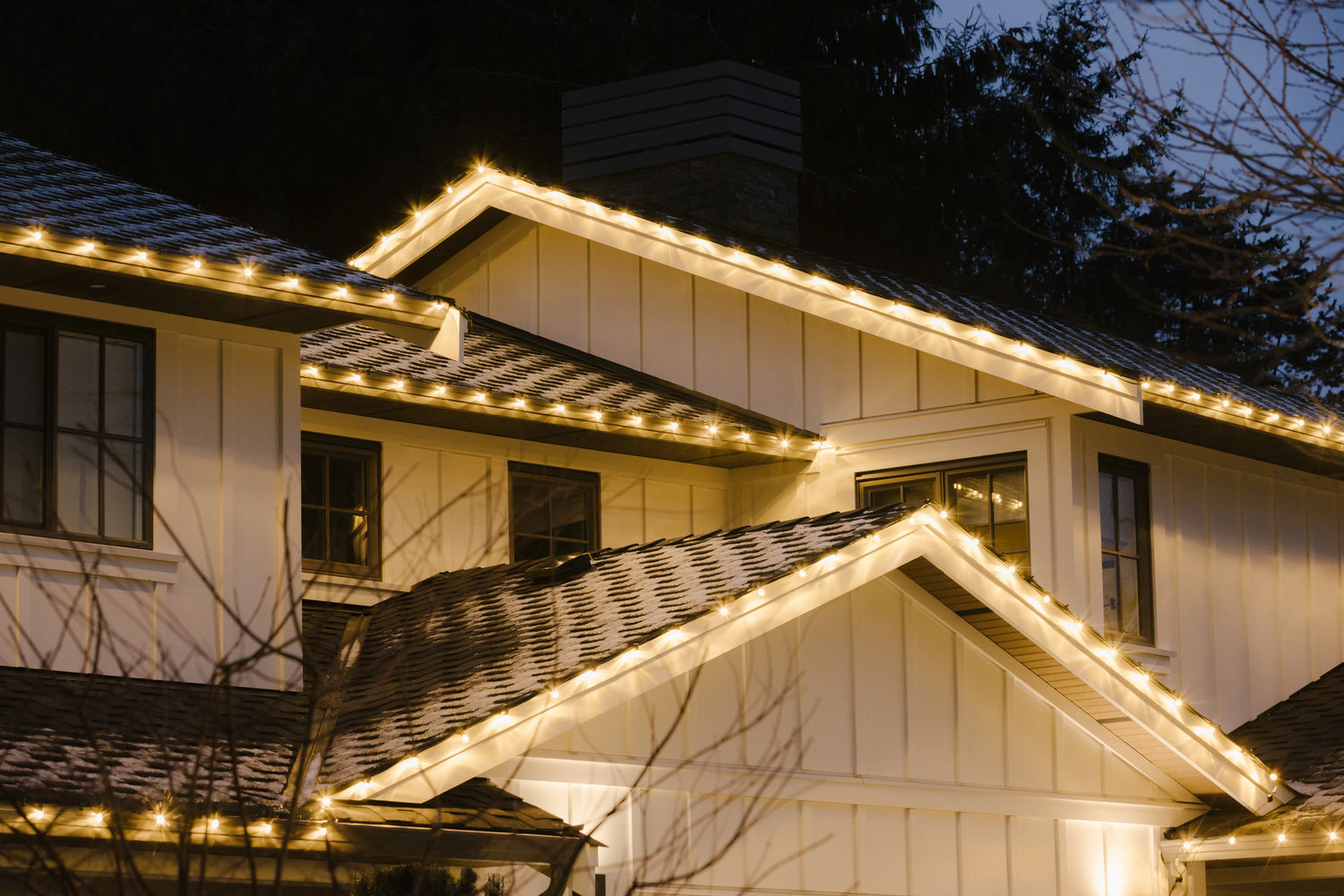Tools for professional Christmas light installers are primarily focused on items that hang, attach, cut, climb and prevent falls.
When peak season rolls around, it’s important to stay organized, too. So here is a list of tools broken up into these categories that you will find helpful when outfitting your Christmas light installers!
Hang:
Poles: One of the handiest tools you’ll ever use is a painting pole with a hook on the end. It’s so simple, but saves countless hours of ladder climbing. In addition, working from the ground is always safer than working from a ladder. Just make sure you take a good look out for power lines (one company in Ontario experienced a fatality from this a few years ago). For an innovative solution, watch our video on building a Christmas light installation pole.

If you want to go the extra mile in providing comfort for your staff, consider investing in a light weight carbon fibre telescoping pole.
Cable and clutchers: When hanging curtain lights or larger ornaments, rope or zip ties might not be strong enough. One easy solution is to use aircraft cable and self-locking clutchers. No crimping required! These tools are widely available from HVAC stores. If they are used outdoors, ensure they are galvanized. Also check the specifications on the cable and clutchers to ensure they will handle the loads required.
Attach:
Clips: The most non-invasive method of attaching lights to buildings is to use plastic Christmas light installation clips. They come in variety of forms that include multi-clips and magnetic clips. Ensure they have UV stabilizers for longer life and use a colour that most closely matches the buildings facade. Remember, it’s the lights you want people to notice...not the clips!

Zip ties: You are going to use lots of these. Get an assortment of sizes from 4” to 14” and in black and clear options. Most hardware stores or electrical wholesalers sell this item.
Electrical tape: This is another item that you’ll use copious amounts of, especially when removing lights as it's handy for holding the neatly coiled bundles together. Get a few coloured ones as well.
Pro tip: when decorating a large tree with a “canopy-wrap” style, place a bit of bright coloured tape on the female end of the run so that you can easily spot it again when the lights are ready to come down. While the lights are installed from the ground up, they will likely need to come down the opposite way to avoid tangles.
Stapler: Use a good wire staple gun with insulated staples. They are pricier, but will significantly reduce chances of cutting the protective plastic on the wires, thus exposing the copper.
Cut:
Wire cutters: Spend the money and get really good wire cutters. Ensure the handles are insulated (just in case you cut a live wire). Cutters with a spring that forces them open are also nice to have. In addition, a vise-grip feature for additional leverage will allow you to easily cut aircraft cable. Finally, ensure they stay sharp so that the copper is cut clean. If there are strands of copper poking out after that cut is made, it can lead to a possible short. Don’t purchase combination pliers/cutters/strippers. You want a separate tool for each of those jobs.

Climb:
Ladders: these are both your friend and enemy. Stay on their good side by respecting them, don’t damage them, and help them out by getting accessories to keep them more stable. Good ladders to start with are 18’ and 32’ aluminum extension ladders. Also orchard ladders and step ladders. Do not cheap out on ladders. This is one of your most important expenditures.

Stand-off arms: This accessory will not only prevent damage to gutters, but they make the ladder more stable as well by providing a wider point of contact on the building. Ensure you keep clean foam on the ends too.
Ladder levellers: This is another MUST-HAVE accessory. Often the ground you are working on is uneven and ladder levellers will allow you to climb ladders much more safely by adjusting the legs so the ladder doesn’t lean to either side while keeping both feet firmly planted to the ground. Check out the Ladder Wedge, a simple and lightweight tool that has many purposes beyond being a ladder leveller.
The Pitch Hopper: Designed to keep your crew safer on steep pitches, the Pitch Hopper is a grippy wedge-shaped tool that can be used as a rooftop shelf or a support to give you more sure footing.
Man lifts or bucket trucks: We are often asked if having a bucket truck is a good idea. While it can certainly be helpful and speed up install times, it’s not always necessary. In addition to the high up-front cost, they are expensive to maintain. If you are just starting out, rent self-propelled man-lifts instead. Once you find yourself booking lifts often, then consider getting a bucket truck.

Prevent Falls:
Fall protection: This is a must. Check your local WorkSafe guidelines to ensure you are meeting the requirements and keeping your installers as safe as possible. If there’s ANY risk of fall, ensure workers are appropriately tied to suitable anchor points. If the job looks sketchy, don’t offer to do it. The last thing clients want is workers hurting themselves on their property. If you tell them it’s too risky and you can’t access it by other means, they’ll understand. Recommend to apply the lights somewhere instead. If they don’t understand, it’s probably a client you don’t want anyway.

Stay Organized:
Plastic totes: You’ll want to keep all lights, tools, equipment etc. in labelled plastic totes in the vehicles. It’s a good idea to store lights in plastic totes as well, but make sure to cut holes in them so that they can breathe and dry out. Otherwise, you might find the lights not working next year due to corrosion.

Tablets: It’s a good idea to send your crew out with tablets. You’ll be able to communicate jobs with photos, the crew can refer to them when on the job site, and they can access calendars so they can stay on schedule. Other apps they’ll use are maps, and possibly a payment processor if you opt to take credit cards. The tablets will also be important for crews to take photos and mapping a removal time.
You’ll undoubtedly find other really useful tools along the way as you gain experience. Always keep safety in mind and spare no expense in this regard. Subscribe to our newsletter below and follow us on social media to learn other tricks of the trade that will help you have a safe and successful Christmas light installation season.


